贴现现金流法计算题答案
《技术经济学》考试题库及答案(七)

《技术经济学》考试题库及答案1、项目是指在一定约束条件下,具有特定目标的一次性事业(或任务)。
2、油气勘探开发项目效益评估方法:贴现现金流法、实物期权法3、技术经济的研究对象:1)研究技术方案、技术措施、技术政策、新技术装备的经济效果,寻找提高经济效果的途径和方法,2)研究技术与经济的相互促进与协调发展,3)研究技术创新,推动技术进步,促进企业发展和国民经济增长。
一、现金流的构成和资金等值计算1、现金流量:技术经济分析中,把各时点上实际发生的以货币形式体现的资金流出或资金流入。
净现金流量(NCF)=现金流入-现金流出。
构成现金流量的基本因素:投资、成本、收入、税金、利润等。
2、固定资产的折旧方法:直线法(年限平均法)、工作量法、双倍余额递减法、年数总和法。
3、总成本费用:指项目在一定时期内(一般为一年)为生产和销售产品而花费的全部成本和费用。
总成本费用中含有既不属于现金流入也不属于现金流出的折旧和摊销费。
4、经营成本(现金流出项)=总成本费用—折旧费—摊销费—利息机会成本是指将一种具有多种用途的有限资源置于某种特定的用途,而放弃的用于其他各种用途的最高收益。
沉没成本是指过去已经支出的,与当前决策无关的成本。
重置成本是指对固定资产以先行价格重新购置或重新制造所需的全部成本。
5、加速折旧法与直线折旧法上缴所得税的总额相等,上缴的时间不同6、销售利润=销售收入-产品营业(销售)税金及附加-产品销售成本-销售费用-管理费用-财务费用(其中后4项的和为总成本费用)。
7、营业净现金流量=营业收入-经营成本-营业税金及附加-所得税=营业收入-(总成本费用-折旧、摊销-利息)-营业税金及附加-所得税=营业收入-总成本费用-营业税金及附加-所得税+折旧、摊销+利息=营业利润-所得税+折旧、摊销+利息=税后利润+折旧、摊销+利息8、销售利润=销售收入-产品销售成本-产品营业(销售)税金及附加-销售费用-管理费用-财务费用=销售收入-总成本费用-产品营业(销售)税金及附加9、资金的时间价值:不同时间发生的等额资金在价值上的差别,影响资金时间价值的大小的主要因素有:投资收益率、通货膨胀、风险因素。
CMA管理会计师-中文Part2-第5章投资决策-1.回收期法和贴现回收期法
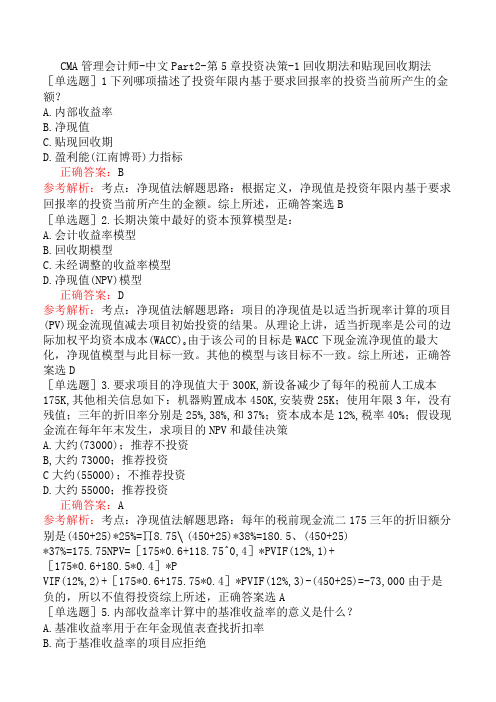
CMA管理会计师-中文Part2-第5章投资决策-1回收期法和贴现回收期法[单选题]1下列哪项描述了投资年限内基于要求回报率的投资当前所产生的金额?A.内部收益率B.净现值C.贴现回收期D.盈利能(江南博哥)力指标正确答案:B参考解析:考点:净现值法解题思路:根据定义,净现值是投资年限内基于要求回报率的投资当前所产生的金额。
综上所述,正确答案选B[单选题]2.长期决策中最好的资本预算模型是:A.会计收益率模型B.回收期模型C.未经调整的收益率模型D.净现值(NPV)模型正确答案:D参考解析:考点:净现值法解题思路:项目的净现值是以适当折现率计算的项目(PV)现金流现值减去项目初始投资的结果。
从理论上讲,适当折现率是公司的边际加权平均资本成本(WACC)o由于该公司的目标是WACC下现金流净现值的最大化,净现值模型与此目标一致。
其他的模型与该目标不一致。
综上所述,正确答案选D[单选题]3.要求项目的净现值大于300K,新设备减少了每年的税前人工成本175K,其他相关信息如下:机器购置成本450K,安装费25K;使用年限3年,没有残值;三年的折旧率分别是25%,38%,和37%;资本成本是12%,税率40%;假设现金流在每年年末发生,求项目的NPV和最佳决策A.大约(73000);推荐不投资B,大约73000;推荐投资C大约(55000);不推荐投资D.大约55000;推荐投资正确答案:A参考解析:考点:净现值法解题思路:每年的税前现金流二175三年的折旧额分别是(450+25)*25%=∏8.75∖(450+25)*38%=180.5、(450+25)*37%=175.75NPV=[175*0.6+118.75^0,4]*PVIF(12%,1)+[175*0.6+180.5*0.4]*PVIF(12%,2)+[175*0.6+175.75*0.4]*PVIF(12%,3)-(450+25)=-73,000由于是负的,所以不值得投资综上所述,正确答案选A[单选题]5.内部收益率计算中的基准收益率的意义是什么?A.基准收益率用于在年金现值表查找折扣率B.高于基准收益率的项目应拒绝C.低于基准收益率的项目应拒绝D.基准收益率被用于在现值系数表中查找折扣率正确答案:C参考解析:考点:内部报酬率解题思路:内部收益率法通过比较估计的内部收益率和预定的收益率来评估资本投资。
财务案例分析综合练习题及答案
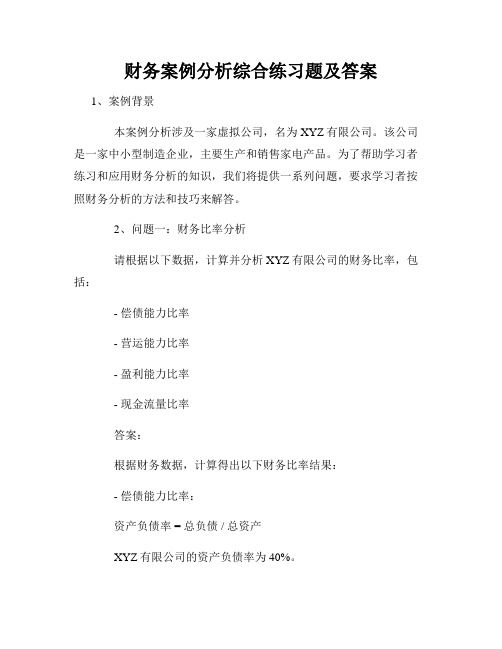
财务案例分析综合练习题及答案1、案例背景本案例分析涉及一家虚拟公司,名为XYZ有限公司。
该公司是一家中小型制造企业,主要生产和销售家电产品。
为了帮助学习者练习和应用财务分析的知识,我们将提供一系列问题,要求学习者按照财务分析的方法和技巧来解答。
2、问题一:财务比率分析请根据以下数据,计算并分析XYZ有限公司的财务比率,包括:- 偿债能力比率- 营运能力比率- 盈利能力比率- 现金流量比率答案:根据财务数据,计算得出以下财务比率结果:- 偿债能力比率:资产负债率 = 总负债 / 总资产XYZ有限公司的资产负债率为40%。
- 营运能力比率:存货周转率 = 营业收入 / 存货XYZ有限公司的存货周转率为6次/年。
- 盈利能力比率:净利润率 = 净利润 / 营业收入XYZ有限公司的净利润率为15%。
- 现金流量比率:现金流入率 = 经营活动产生的现金流入 / 净利润XYZ有限公司的现金流入率为120%。
综合以上分析,XYZ有限公司的偿债能力较强,营运能力较高,盈利能力相对稳定,现金流量充裕。
3、问题二:经济价值评估在企业并购评估中,经济价值评估是重要的参考指标。
请根据给定数据,计算并分析XYZ有限公司的经济价值。
答案:根据现金流量贴现模型(DCF),我们可以得出以下经济价值评估结果:- 初始投资(CF0):800,000 万元- 年现金流量(CF1-CF5):200,000 万元- 折现率:8%计算得到的现金流量贴现值如下:CF0 = 800,000 万元CF1 = 200,000 / (1 + 0.08)^1 = 185,185.19 万元CF2 = 200,000 / (1 + 0.08)^2 = 171,467.76 万元CF3 = 200,000 / (1 + 0.08)^3 = 158,730.16 万元CF4 = 200,000 / (1 + 0.08)^4 = 146,850.14 万元CF5 = 200,000 / (1 + 0.08)^5 = 135,734.39 万元经济价值(PV)= CF0 + CF1 + CF2 + CF3 + CF4 + CF5经济价值(PV)= 800,000 + 185,185.19 + 171,467.76 +158,730.16 + 146,850.14 + 135,734.39 = 1,597,967.64 万元综合以上分析,XYZ有限公司的经济价值为1,597,967.64 万元。
朱叶公司金融第二版【课后习题答案】

【复旦大学 431 金融学考研专业课重难点】
复旦大学 431 金融学专业课一共四门课程,即《投资学》, 《货币银行学》,《国际金融学》以及《公司金融学》。这四门课 的重要程度排序为:《国际金融学》,《投资学》,《公司金融》,《货
3
朱叶——《公司金融》——课后习题详解
点进行系统梳理,总结归纳就显得非常重要。
三、注重实际运用
我个人认为,对金融学把握不太好的表现之一就是不会实际 运用。例如,中国的广义货币(M2)当前存量大概为 80 万亿, 有同学会去根据中国的高能货币以及货币乘数算出来这个货币 存量吗?例如,同学们都学过国际金本位体系,布雷顿森林体系, 牙买加体系的知识。那么可否根据这些知识说明当前国际收支体 系的问题、汇率调节机制的问题或者未来国际收支体系的发展方 向?实际上,这些问题并不难以回答,仍然跳不出我们在书本上 学到的知识,只是很多同学从来没尝试过用书本上的知识来解释 现实。因此,学会实际运用,不仅可以使得同学们对知识理解得 更加深刻,更重要的是,它会使得同学们养成自己的经济学金融 学思维,而这正是复旦大学经济学院研究生所必须具备的素质!
(3)企业的投资决策问题。由于投资企业是创造和利用投资机会的最佳工具,从而成 为经济发展的根本驱动力。但在公司金融理论的研究中,一般都遵循费雪的分离原理,即公
7
朱叶——《公司金融》——课后习题详解
司的投资与融资决策是相分离的,莫迪格利安尼与米勒(1958)的开创性论文对此做了较为 严格的证明。然而,现实中的企业即使面临无限的投资机会,并不可能获得全部足够的资金 支持。因此,由于各种原因,企业可能面临着投资不足或者投资过度的两难处境。为了保证 企业能够有效把握投资机会,并能从可供选择的投资机会中筛选出最能实现其市场价值最大 化的投资项目,需要运用相应的金融技术与程序。随着金融理论与技术的发展,资本预算的 方法与程序,也处于不断的发展过程之中。
贴现现金流量法计算公式

贴现现金流量法计算公式贴现现金流量法(DCF)是一种常用的财务计算方法。
它通过将未来的现金流量折现至当前时点,来评估一个投资项目、资产或企业的价值。
贴现现金流量法的计算公式如下:PV = CF1 / (1+r)^1 + CF2 / (1+r)^2 + ... CFn / (1+r)^n其中,PV表示当前时点的现值(Present Value);CF1,CF2,... CFn表示未来的现金流量,分别对应不同时间点(1年,2年,... n年)的现金流入或支出;r表示贴现率(Discount Rate),即衡量现金流量的时间价值。
通过将未来的现金流量进行贴现,我们可以将不同时间点的现金流量进行可比较的价值评估。
贴现率的选择非常重要,因为贴现率反映了投资的风险和市场的机会成本。
通常,公司会根据自身的风险特征和市场情况来确定贴现率。
在计算过程中,我们需要对未来的现金流量进行预测。
这需要考虑多种因素,如市场需求、竞争状况、成本变化等。
同时,对于长期投资项目,还需要考虑通货膨胀因素,将未来现金流量进行实际值或实际增值的估算。
贴现现金流量法的优点在于,它能够对未来现金流量的时间价值进行综合考量,提供了一种相对准确的评估方法。
然而,这种方法也存在一些限制。
首先,它对未来现金流量的预测要求较高,且对于长期投资,预测的不确定性较大。
其次,贴现率的选择可能存在主观性和不确定性。
总之,贴现现金流量法是一种常用的财务计算方法,可用于评估投资项目、资产或企业的价值。
通过将未来现金流量进行贴现,它能够提供一种可比较的评估手段,帮助投资者做出理性决策。
然而,在使用该方法时需要注意对未来现金流量的预测和贴现率的选择。
自由现金流贴现法
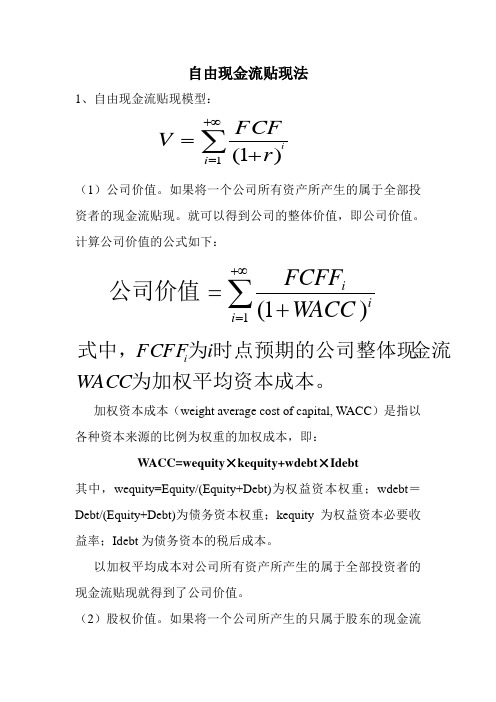
试计算
(1)2013 年东方建设的股权价值和企业价值; (2)2008 年东方建设的股权价值和企业价值. 解:(1) 2013 东方建设的股权价值为:
V2013股权价值
i 1
FCFEi (1 k)i
FCFE 2014 kg
118 .24 985 .33 15% 3%
2013 东方建设的企业价值为:
112% (112%)2 (112%)3 (112%)4
148.82 (1 12% )5
1758.67 (1 12% )5
1444.22
增长率 15% 12% 9%
6%
3%
3%
FCFE 80
91.20 101.23 109.33 114.80 118.24
增长率 14% 11% 8%
5%
3%
3%
东方建设从 2013 年开始进入稳定增长期,增长率为 3%。
东方建设的资本结构及资本成本为:
目标 D/E=50%;
权益资本成本为 15%;
税后债务资本成本为 6%
权益资本成本是公司权益投资者所要求的回报率。以权益资 本成本对属于公司股东的现金流贴现就得到了股权价值。
虽然这两种方法所使用的现金流及贴现率不同,但是若假设 条件相同,就会得到一致的结论。因为公司价值应该等于股权价 值与公司净债务之和,即
公司价值=股权价值+净债务 其中,
净债务=公司总债务-现金及现金等价物 2、自由现金流贴现法的特点:
企业加权资本成本 WACC 为 :
WACC
we
k
wd
I
2 15% 3
1 6% 3
12%
V2013企业价值
i 1
FCFFi (1 WACC )i
财务管理章节练习题 第6章

财务管理章节练习题第6章一、单项选择题1、某公司下属两个分厂,一分厂从事生物医药产品生产和销售,年销售收入3000万元,现在二分厂准备投资一项目从事生物医药产品生产和销售,预计该项目投产后每年为二分厂带来销售收入2000万元,但由于和一分厂形成竞争,每年使得一分厂销售收入减少400万元,那么从该公司的角度出发,二分厂投资该项目预计的年现金流入为()万元。
A、5000B、2000C、4600D、1600答案:D解析:估算现金流量时应当注意:必须是项目的增量现金流量;考虑项目对企业其他部门的影响。
综合考虑以上因素,二分厂投资该项目预计的年现金流入=2000-400=1600(万元)。
一分厂年销售收入3000万元为无关现金流量。
2、当贴现率为10%时,某项目的净现值为500元,则说明该项目的内含报酬率()。
A、高于10%B、低于10%C、等于10%D、无法界定答案:A解析:贴现率与净现值呈反向变化,所以当贴现率为10%时,某项目的净现值为500元大于零,要想使净现值向等于零靠近(此时的贴现率为内含报酬率),即降低净现值,需进一步提高贴现率,故知该项目的内含报酬率高于10%。
3、下列无法直接利用净现金流量信息计算的指标是()。
A、投资回收期B、投资利润率C、净现值D、内含报酬率答案:B解析:投资利润率无法直接利用净现金流量信息计算。
4、原始投资额不同,特别是项目计算期不同的多方案比较决策,最适合采用的评价方法是()。
A、获利指数法B、内部收益率法C、差额投资内部收益率法D、年等额净回收额法答案:D解析:多个互斥方案的比较与优选:(1)当原始投资相同且项目计算期相等时:即可以选择净现值或净现值率大的方案作为最优方案。
(2)当原始投资不相同时:即可以选择差额投资内部收益率法和年等额净回收额法进行决策,后者尤其适用于项目计算期不同的多方案比较决策。
5、下列指标中,反映项目投资总体规模的价值指标是()。
A、原始投资总额B、投资总额C、投资成本D、建设成本答案:B解析:投资总额是一个反映项目投资总体规模的价值指标,它等于原始总投资与建设期资本化利息之和。
DCF自由现金流贴现法估值实战案例
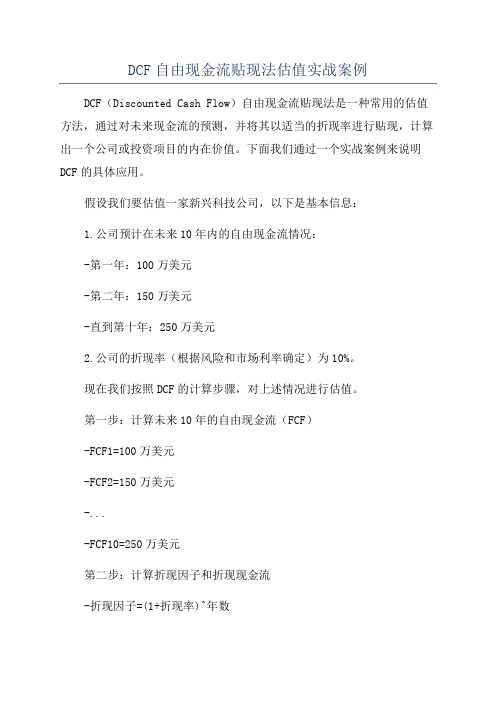
DCF自由现金流贴现法估值实战案例DCF(Discounted Cash Flow)自由现金流贴现法是一种常用的估值方法,通过对未来现金流的预测,并将其以适当的折现率进行贴现,计算出一个公司或投资项目的内在价值。
下面我们通过一个实战案例来说明DCF的具体应用。
假设我们要估值一家新兴科技公司,以下是基本信息:1.公司预计在未来10年内的自由现金流情况:-第一年:100万美元-第二年:150万美元-直到第十年:250万美元2.公司的折现率(根据风险和市场利率确定)为10%。
现在我们按照DCF的计算步骤,对上述情况进行估值。
第一步:计算未来10年的自由现金流(FCF)-FCF1=100万美元-FCF2=150万美元-...-FCF10=250万美元第二步:计算折现因子和折现现金流-折现因子=(1+折现率)^年数-折现因子1=(1+10%)^1=1.1-折现因子2=(1+10%)^2=1.21-...-折现因子10=(1+10%)^10=2.5937-折现现金流=FCF/折现因子-折现现金流1=100万美元/1.1≈90.91万美元-折现现金流2=150万美元/1.21≈123.97万美元-...-折现现金流10=250万美元/2.5937≈96.49万美元第三步:计算现值(PV)-PV=折现现金流之和-PV=折现现金流1+折现现金流2+...+折现现金流10≈90.91万美元+123.97万美元+...+96.49万美元第四步:计算终值(FV)-FV=最后一年的FCF*(1+折现率)/(折现率-成长率) -成长率=5%(假设公司在第十年后的FCF增长率)-FV=250万美元*(1+10%)/(10%-5%)≈5000万美元第五步:计算股权价值(Equity Value)- Equity Value = PV + FV- Equity Value = PV + 5000万美元以上是DCF估值的计算步骤,根据具体数字进行计算得出的股权价值即为估值结果。
2020年中山会计人员继续教育专业课97分

2020年会计人员继续教育专业课(企业类)考试• 1. [单选题]企业风险管理应与企业的战略设定、经营管理与业务流程相结合。
符合()。
o A. 全面性原则o B.融合性原则o C.重要性原则o D.平衡性原则试题分析:正确答案:B你的答案:B正确答案:B 解析:管理会计应用指引第700号第三条规定。
• 2. [单选题]()是以明确的假设为基础,选择恰当的贴现率对预期的各期现金流入、流出进行贴现,通过贴现值的计算和比较,为财务合理性提供判断依据的价值评估方法。
o A.投资报酬率法o B. 贴现现金流法o C. 成本控制法o D. 差额分析法试题分析:正确答案:B你的答案:Bnull【答案】B 【解析】贴现现金流法,是以明确的假设为基础,选择恰当的贴现率对预期的各期现金流入、流出进行贴现,通过贴现值的计算和比较,为财务合理性提供判断依据的价值评估方法。
故选项B正确。
• 3. [单选题]在管理会计信息系统(),企业应制定详尽的实施计划,清晰划分实施的主要阶段、有关活动和详细任务的时间进度。
o A. 规划环节o B. 实施环节o C. 分析环节o D. 报告环节试题分析:正确答案:B你的答案:Bnull【答案】B 【解析】在管理会计信息系统实施环节,企业应制定详尽的实施计划,清晰划分实施的主要阶段、有关活动和详细任务的时间进度。
实施阶段一般包括项目准备、系统设计、系统实现、测试和上线、运维及支持等过程。
故选项B正确。
• 4. [单选题]有关因素只要有较小幅度变动就会引起利润较大幅度变动的,属于()。
o A.非相关因素o B. 敏感性因素o C. 有关联因素o D. 弱敏感性因素试题分析:正确答案:B你的答案:Bnull【答案】B 【解析】有关因素只要有较小幅度变动就会引起利润较大幅度变动的,属于敏感性因素;有关因素虽有较大幅度变动但对利润影响不大的,属于弱敏感性因素。
故选项B正确。
• 5. [单选题]()是指将企业的战略目标变成现实的管理过程。
《公司金融》朱叶-第二版【课后习题答案】
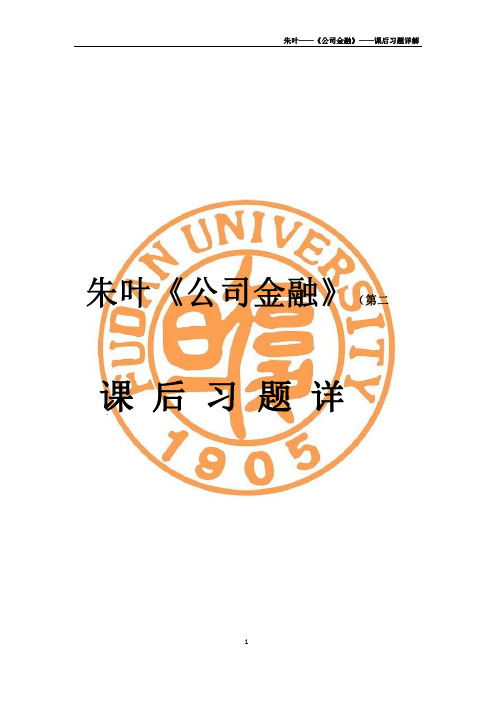
第三,公司拥有更多的再投资机会。因为公司比合伙制企业和个体业主企业更容易留存企业的当期收益,因此,更有利于今后再投资于有利可图的投资机会。
以上三点第一点是专业课考高分的必要条件。第二点和第三点若做到其中之一,则专业课分数必上110(运气好点可以上120),若三点全部做到专业课分数至少120(稍不留神就上130)。
【复旦大学431金融学考研专业课重难点】
复旦大学431金融学专业课一共四门课程,即《投资学》,
《货币银行学》,《国际金融学》以及《公司金融学》。这四门课的重要程度排序为:《国际金融学》,《投资学》,《公司金融》,《货
3.
【参考答案】公司的财务目标有单一和多元之说。就单一目标而言,关于公司的财务目标有多种观点。利润最大化目标、收入最大化目标、股东财富最大化目标是最重要的几种公司目标说。股东财富最大化也称股东价值最大化,如果考虑债权人对公司财务要求权的话,公司财务目标也可称为公司价值最大化或公司财富最大化。股东财富最大化目标避免了利润最大化或收入最大化目标的三个缺陷。首先,股东财富基于期望流向股东的未来现金流量,内涵非常明确,而不是模糊的利润或收入;其次,股东财富明确地取决于未来现金流量的时间;最后,股东财富的计算过程考虑风险差异。因此,股东财富最大化是公司最合适的财务目标。
信息不对称下的新资本结构理论新现代资本结构的研究从20世纪80年代开始引入信息经济学博弈论等领域的最新研究方法突破了传统资本结构单纯研究筹资结构的权衡问题并试图借助非对称信息理论中的信号动机激励经理人博弈等概念从公司所有者内部管理者以及外部投资者之间的相互作用从对公司价值的影响角度来诠释资本结构问题
第3章-资本预算补充练习及答案
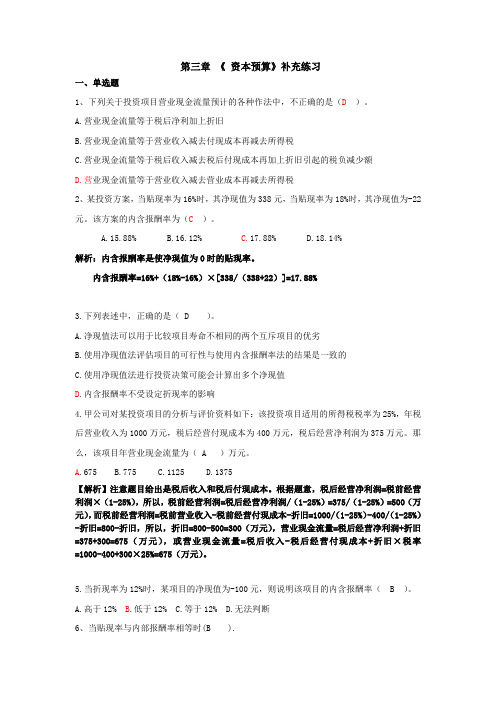
第三章《资本预算》补充练习一、单选题1、下列关于投资项目营业现金流量预计的各种作法中,不正确的是(D)。
A.营业现金流量等于税后净利加上折旧B.营业现金流量等于营业收入减去付现成本再减去所得税C.营业现金流量等于税后收入减去税后付现成本再加上折旧引起的税负减少额D.营业现金流量等于营业收入减去营业成本再减去所得税2、某投资方案,当贴现率为16%时,其净现值为338元,当贴现率为18%时,其净现值为-22元。
该方案的内含报酬率为(C)。
A.15.88%B.16.12%C.17.88%D.18.14%解析:内含报酬率是使净现值为0时的贴现率。
内含报酬率=16%+(18%-16%)×[338/(338+22)]=17.88%3.下列表述中,正确的是( D )。
A.净现值法可以用于比较项目寿命不相同的两个互斥项目的优劣B.使用净现值法评估项目的可行性与使用内含报酬率法的结果是一致的C.使用净现值法进行投资决策可能会计算出多个净现值D.内含报酬率不受设定折现率的影响4.甲公司对某投资项目的分析与评价资料如下:该投资项目适用的所得税税率为25%,年税后营业收入为1000万元,税后经营付现成本为400万元,税后经营净利润为375万元。
那么,该项目年营业现金流量为( A )万元。
A.675B.775C.1125D.1375【解析】注意题目给出是税后收入和税后付现成本。
根据题意,税后经营净利润=税前经营利润×(1-25%),所以,税前经营利润=税后经营净利润/(1-25%)=375/(1-25%)=500(万元),而税前经营利润=税前营业收入-税前经营付现成本-折旧=1000/(1-25%)-400/(1-25%)-折旧=800-折旧,所以,折旧=800-500=300(万元),营业现金流量=税后经营净利润+折旧=375+300=675(万元),或营业现金流量=税后收入-税后经营付现成本+折旧×税率=1000-400+300×25%=675(万元)。
《金融学》答案第四章 货币的时间价值与现金流贴现分析
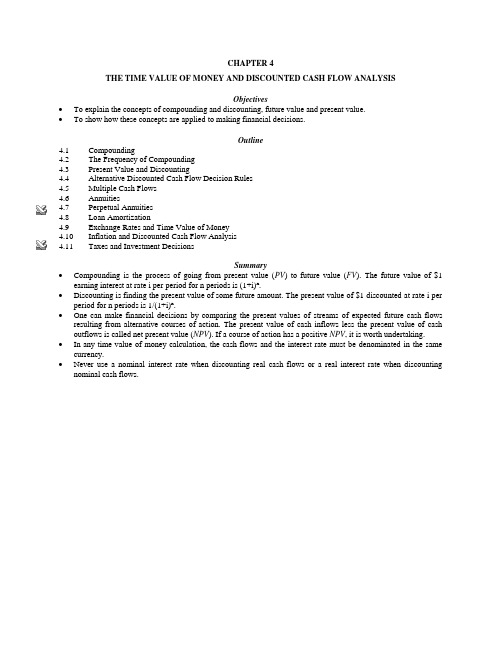
CHAPTER 4THE TIME VALUE OF MONEY AND DISCOUNTED CASH FLOW ANALYSISObjectives•To explain the concepts of compounding and discounting, future value and present value.•To show how these concepts are applied to making financial decisions.Outline4.1 Compounding4.2 The Frequency of Compounding4.3 Present Value and Discounting4.4 Alternative Discounted Cash Flow Decision Rules4.5 Multiple Cash Flows4.6 Annuities4.7 Perpetual Annuities4.8 Loan Amortization4.9 Exchange Rates and Time Value of Money4.10 Inflation and Discounted Cash Flow Analysis4.11 Taxes and Investment DecisionsSummary•Compounding is the process of going from present value (PV) to future value (FV). The future value of $1 earning interest at rate i per period for n periods is (1+i)n.•Discounting is finding the present value of some future amount. The present value of $1 discounted at rate i per period for n periods is 1/(1+i)n.•One can make financial decisions by comparing the present values of streams of expected future cash flows resulting from alternative courses of action. The present value of cash inflows less the present value of cash outflows is called net present value (NPV). If a course of action has a positive NPV, it is worth undertaking. •In any time value of money calculation, the cash flows and the interest rate must be denominated in the same currency.•Never use a nominal interest rate when discounting real cash flows or a real interest rate when discounting nominal cash flows.How to Do TVM Calculations in MS ExcelAssume you have the following cash flows set up in a spreadsheet:Move the cursor to cell B6 in the spreadsheet. Click the function wizard f x in the tool bar and when a menu appears, select financial and then NPV. Then follow the instructions for inputting the discount rate and cash flows. You can input the column of cash flows by selecting and moving it with your mouse. Ultimately cell B6should contain the following:=NPV(0.1,B3:B5)+B2The first variable in parenthesis is the discount rate. Make sure to input the discount rate as a decimal fraction (i.e., 10% is .1). Note that the NPV function in Excel treats the cash flows as occurring at the end of each period, and therefore the initial cash flow of 100 in cell B2 is added after the closing parenthesis. When you hit the ENTER key, the result should be $47.63.Now move the cursor to cell B7to compute IRR. This time select IRR from the list of financial functions appearing in the menu. Ultimately cell B7 should contain the following:=IRR(B2:B5)When you hit the ENTER key, the result should be 34%.Your spreadsheet should look like this when you have finished:Solutions to Problems at End of Chapter1. If you invest $1000 today at an interest rate of 10% per year, how much will you have 20 years from now,assuming no withdrawals in the interim?2. a. If you invest $100 every year for the next 20 years, starting one year from today and you earninterest of 10% per year, how much will you have at the end of the 20 years?b. How much must you invest each year if you want to have $50,000 at the end of the 20 years?3. What is the present value of the following cash flows at an interest rate of 10% per year?a. $100 received five years from now.b. $100 received 60 years from now.c. $100 received each year beginning one year from now and ending 10 years from now.d. $100 received each year for 10 years beginning now.e. $100 each year beginning one year from now and continuing forever.e. PV = $100 = $1,000.104. You want to establish a “wasting” fund which will provide you with $1000 per year for four years, at which time the fund will be exhausted. How much must you put in the fund now if you can earn 10% interest per year?SOLUTION:5. You take a one-year installment loan of $1000 at an interest rate of 12% per year (1% per month) to be repaid in 12 equal monthly payments.a. What is the monthly payment?b. What is the total amount of interest paid over the 12-month term of the loan?SOLUTION:b. 12 x $88.85 - $1,000 = $66.206. You are taking out a $100,000 mortgage loan to be repaid over 25 years in 300 monthly payments.a.If the interest rate is 16% per year what is the amount of the monthly payment?b.If you can only afford to pay $1000 per month, how large a loan could you take?c.If you can afford to pay $1500 per month and need to borrow $100,000, how many months would it taketo pay off the mortgage?d.If you can pay $1500 per month, need to borrow $100,000, and want a 25 year mortgage, what is thehighest interest rate you can pay?SOLUTION:a.Note: Do not round off the interest rate when computing the monthly rate or you will not get the same answerreported here. Divide 16 by 12 and then press the i key.b.Note: You must input PMT and PV with opposite signs.c.Note: You must input PMT and PV with opposite signs.7. In 1626 Peter Minuit purchased Manhattan Island from the Native Americans for about $24 worth of trinkets. If the tribe had taken cash instead and invested it to earn 6% per year compounded annually, how much would the Indians have had in 1986, 360 years later?SOLUTION:8. You win a $1 million lottery which pays you $50,000 per year for 20 years, beginning one year from now. How much is your prize really worth assuming an interest rate of 8% per year?SOLUTION:9. Your great-aunt left you $20,000 when she died. You can invest the money to earn 12% per year. If you spend $3,540 per year out of this inheritance, how long will the money last?SOLUTION:10. You borrow $100,000 from a bank for 30 years at an APR of 10.5%. What is the monthly payment? If you must pay two points up front, meaning that you only get $98,000 from the bank, what is the true APR on the mortgage loan?SOLUTION:If you must pay 2 points up front, the bank is in effect lending you only $98,000. Keying in 98000 as PV and computing i, we get:11. Suppose that the mortgage loan described in question 10 is a one-year adjustable rate mortgage (ARM), which means that the 10.5% interest applies for only the first year. If the interest rate goes up to 12% in the second year of the loan, what will your new monthly payment be?SOLUTION:Step 2 is to compute the new monthly payment at an interest rate of 1% per month:12. You just received a gift of $500 from your grandmother and you are thinking about saving this money for graduation which is four years away. You have your choice between Bank A which is paying 7% for one-year deposits and Bank B which is paying 6% on one-year deposits. Each bank compounds interest annually. What is the future value of your savings one year from today if you save your money in Bank A? Bank B? Which is the better decision? What savings decision will most individuals make? What likely reaction will Bank B have? SOLUTION:$500 x (1.07) = $535Formula:$500 x (1.06) = $530a.You will decide to save your money in Bank A because you will have more money at the end of the year. Youmade an extra $5 because of your savings decision. That is an increase in value of 1%. Because interestcompounded only once per year and your money was left in the account for only one year, the increase in value is strictly due to the 1% difference in interest rates.b.Most individuals will make the same decision and eventually Bank B will have to raise its rates. However, it isalso possible that Bank A is paying a high rate just to attract depositors even though this rate is not profitable for the bank. Eventually Bank A will have to lower its rate to Bank B’s rate in order to make money.13.Sue Consultant has just been given a bonus of $2,500 by her employer. She is thinking about using the money to start saving for the future. She can invest to earn an annual rate of interest of 10%.a.According to the Rule of 72, approximately how long will it take for Sue to increase her wealth to $5,000?b.Exactly how long does it actually take?SOLUTION:a.According to the Rule of 72: n = 72/10 = 7.2 yearsIt will take approximately 7.2 years for Sue’s $2,500 to double to $5,000 at 10% interest.b.At 10% interestn i PV FV PMTSolve10 - $2,500 $5,0007.27 YearsFormula:$2,500 x (1.10)n = $5,000Hence, (1.10)n = 2.0n log 1.10 = log 2.0n = .693147 = 7.27 Years.095310rry’s bank account has a “floating” interest rate on certai n deposits. Every year the interest rate is adjusted. Larry deposited $20,000 three years ago, when interest rates were 7% (annual compounding). Last year the rate was only 6%, and this year the rate fell again to 5%. How much will be in his account at the end of this year?SOLUTION:$20,000 x 1.07 x 1.06 x 1.05 = $23,818.2015.You have your choice between investing in a bank savings account which pays 8% compounded annually (BankAnnual) and one which pays 7.5% compounded daily (BankDaily).a.Based on effective annual rates, which bank would you prefer?b.Suppose BankAnnual is only offering one-year Certificates of Deposit and if you withdraw your moneyearly you lose all interest. How would you evaluate this additional piece of information when making your decision?SOLUTION:a.Effective Annual Rate: BankAnnual = 8%.Effective Annual Rate BankDaily = [1 + .075]365 - 1 = .07788 = 7.788%365Based on effective annual rates, you would prefer BankAnnual (you will earn more money.)b.If BankAnnual’s 8% annual return is conditioned upon leaving the money in for one full year, I would need tobe sure that I did not need my money within the one year period. If I were unsure of when I might need the money, it might be safer to go for BankDaily. The option to withdraw my money whenever I might need it will cost me the potential difference in interest:FV (BankAnnual) = $1,000 x 1.08 = $1,080FV (BankDaily) = $1,000 x 1.07788 = $1,077.88Difference = $2.12.16.What are the effective annual rates of the following:a.12% APR compounded monthly?b.10% APR compounded annually?c.6% APR compounded daily?SOLUTION:Effective Annual Rate (EFF) = [1 + APR] m - 1ma.(1 + .12)12 - 1 = .1268 = 12.68%12b.(1 + .10)- 1 = .10 = 10%1c.(1 + .06)365 - 1 = .0618 = 6.18%36517.Harry promises that an investment in his firm will double in six years. Interest is assumed to be paid quarterly and reinvested. What effective annual yield does this represent?EAR=(1.029302)4-1=12.25%18.Suppose you know that you will need $2,500 two years from now in order to make a down payment on a car.a.BankOne is offering 4% interest (compounded annually) for two-year accounts, and BankTwo is offering4.5% (compounded annually) for two-year accounts. If you know you need $2,500 two years from today,how much will you need to invest in BankOne to reach your goal? Alternatively, how much will you need to invest in BankTwo? Which Bank account do you prefer?b.Now suppose you do not need the money for three years, how much will you need to deposit today inBankOne? BankTwo?SOLUTION:PV = $2,500 = $2,311.39(1.04)2PV = $2,500 = $2,289.32(1.045)2You would prefer BankTwo because you earn more; therefore, you can deposit fewer dollars today in order to reach your goal of $2,500 two years from today.b.PV = $2,500 = $2,222.49(1.04)3PV = $2,500 = $2,190.74(1.045)3Again, you would prefer BankTwo because you earn more; therefore, you can deposit fewer dollars today in order to reach your goal of $2,500 three years from today.19.Lucky Lynn has a choice between receiving $1,000 from her great-uncle one year from today or $900 from her great-aunt today. She believes she could invest the $900 at a one-year return of 12%.a.What is the future value of the gift from her great-uncle upon receipt? From her great-aunt?b.Which gift should she choose?c.How does your answer change if you believed she could invest the $900 from her great-aunt at only 10%?At what rate is she indifferent?SOLUTION:a. Future Value of gift from great-uncle is simply equal to what she will receive one year from today ($1000). Sheearns no interest as she doesn’t receive the money until next year.b. Future Value of gift from great-aunt: $900 x (1.12) = $1,008.c. She should choose the gift from her great-aunt because it has future value of $1008 one year from today. Thegift from her great-uncle has a future value of $1,000. This assumes that she will able to earn 12% interest on the $900 deposited at the bank today.d. If she could invest the money at only 10%, the future value of her investment from her great-aunt would only be$990: $900 x (1.10) = $990. Therefore she would choose the $1,000 one year from today. Lucky Lynn would be indifferent at an annual interest rate of 11.11%:$1000 = $900 or (1+i) = 1,000 = 1.1111(1+i) 900i = .1111 = 11.11%20.As manager of short-term projects, you are trying to decide whether or not to invest in a short-term project that pays one cash flow of $1,000 one year from today. The total cost of the project is $950. Your alternative investment is to deposit the money in a one-year bank Certificate of Deposit which will pay 4% compounded annually.a.Assuming the cash flow of $1,000 is guaranteed (there is no risk you will not receive it) what would be alogical discount rate to use to determine the present value of the cash flows of the project?b.What is the present value of the project if you discount the cash flow at 4% per year? What is the netpresent value of that investment? Should you invest in the project?c.What would you do if the bank increases its quoted rate on one-year CDs to 5.5%?d.At what bank one-year CD rate would you be indifferent between the two investments?SOLUTION:a.Because alternative investments are earning 4%, a logical choice would be to discount the project’s cash flowsat 4%. This is because 4% can be considered as your opportunity cost for taking the project; hence, it is your cost of funds.b.Present Value of Project Cash Flows:PV = $1,000 = $961.54(1.04)The net present value of the project = $961.54 - $950 (cost) = $11.54The net present value is positive so you should go ahead and invest in the project.c.If the bank increased its one-year CD rate to 5.5%, then the present value changes to:PV = $1,000 = $947.87(1.055)Now the net present value is negative: $947.87 - $950 = - $2.13. Therefore you would not want to invest in the project.d.You would be indifferent between the two investments when the bank is paying the following one-year interestrate:$1,000 = $950 hence i = 5.26%(1+i)21.Calculate the net present value of the following cash flows: you invest $2,000 today and receive $200 one year from now, $800 two years from now, and $1,000 a year for 10 years starting four years from now. Assume that the interest rate is 8%.SOLUTION:Since there are a number of different cash flows, it is easiest to do this problem using cash flow keys on the calculator:22.Your cousin has asked for your advice on whether or not to buy a bond for $995 which will make one payment of $1,200 five years from today or invest in a local bank account.a.What is the internal rate of return on the bond’s cash flows? What additional information do you need tomake a choice?b.What advice would you give her if you learned the bank is paying 3.5% per year for five years(compounded annually?)c.How would your advice change if the bank were paying 5% annually for five years? If the price of thebond were $900 and the bank pays 5% annually?SOLUTION:a.$995 x (1+i)5 = $1,200.(1+i)5 = $1,200$995Take 5th root of both sides:(1+i) =1.0382i = .0382 = 3.82%In order to make a choice, you need to know what interest rate is being offered by the local bank.b.Upon learning that the bank is paying 3.5%, you would tell her to choose the bond because it is earning a higherrate of return of 3.82% .c.If the bank were paying 5% per year, you would tell her to deposit her money in the bank. She would earn ahigher rate of return.5.92% is higher than the rate the bank is paying (5%); hence, she should choose to buy the bond.23.You and your sister have just inherited $300 and a US savings bond from your great-grandfather who had left them in a safe deposit box. Because you are the oldest, you get to choose whether you want the cash or the bond. The bond has only four years left to maturity at which time it will pay the holder $500.a.If you took the $300 today and invested it at an interest rate 6% per year, how long (in years) would ittake for your $300 to grow to $500? (Hint: you want to solve for n or number of periods. Given these circumstances, which are you going to choose?b.Would your answer change if you could invest the $300 at 10% per year? At 15% per year? What otherDecision Rules could you use to analyze this decision?SOLUTION:a.$300 x (1.06)n = $500(1.06)n = 1.6667n log 1.06 = log 1.6667n = .510845 = 8.77 Years.0582689You would choose the bond because it will increase in value to $500 in 4 years. If you tookthe $300 today, it would take more than 8 years to grow to $500.b.You could also analyze this decision by computing the NPV of the bond investment at the different interest rates:In the calculations of the NPV, $300 can be considered your “cost” for acquiring the bond since you will give up $300 in cash by choosing the bond. Note that the first two interest rates give positive NPVs for the bond, i.e. you should go for the bond, while the last NPV is negative, hence choose the cash instead. These results confirm the previous method’s results.24.Suppose you have three personal loans outstanding to your friend Elizabeth. A payment of $1,000 is due today, a $500 payment is due one year from now and a $250 payment is due two years from now. You would like to consolidate the three loans into one, with 36 equal monthly payments, beginning one month from today. Assume the agreed interest rate is 8% (effective annual rate) per year.a.What is the annual percentage rate you will be paying?b.How large will the new monthly payment be?SOLUTION:a.To find the APR, you must first compute the monthly interest rate that corresponds to an effective annual rate of8% and then multiply it by 12:1.08 = (1+ i)12Take 12th root of both sides:1.006434 = 1+ ii = .006434 or .6434% per monthOr using the financial calculator:b.The method is to first compute the PV of the 3 loans and then compute a 36 month annuity payment with thesame PV. Most financial calculators have keys which allow you to enter several cash flows at once. This approach will give the user the PV of the 3 loans.Note: The APR used to discount the cash flows is the effective rate in this case, because this method is assuming annual compounding.25.As CEO of ToysRFun, you are offered the chance to participate, without initial charge, in a project that produces cash flows of $5,000 at the end of the first period, $4,000 at the end of the next period and a loss of $11,000 at the end of the third and final year.a.What is the net present value if the relevant discount rate (the company’s cost o f capital) is 10%?b.Would you accept the offer?c.What is the internal rate of return? Can you explain why you would reject a project which has aninternal rate of return greater than its cost of capital?SOLUTION:At 10% discount rate:Net Present Value = - 0 + $5,000 + $4,000 - $11,000 = - 413.22(1.10) (1.10)2 (1.10)3c.This example is a project with cash flows that begin positive and then turn negative--it is like a loan. The 13.6% IRR is therefore like an interest rate on that loan. The opportunity to take a loan at 13.6% when the cost of capital is only 10% is not worthwhile.26.You must pay a creditor $6,000 one year from now, $5,000 two years from now, $4,000 three years from now, $2,000 four years from now, and a final $1,000 five years from now. You would like to restructure the loan into five equal annual payments due at the end of each year. If the agreed interest rate is 6% compounded annually, what is the payment?SOLUTION:Since there are a number of different cash flows, it is easiest to do the first step of this problem using cash flow keys on the calculator. To find the present value of the current loan payments:27.Find the future value of the following ordinary annuities (payments begin one year from today and all interest rates compound annually):a.$100 per year for 10 years at 9%.b.$500 per year for 8 years at 15%.c.$800 per year for 20 years at 7%.d.$1,000 per year for 5 years at 0%.e.Now find the present values of the annuities in a-d.f.What is the relationship between present values and future values?SOLUTION:Future Value of Annuity:e.f.The relationship between present value and future value is the following:nbeginning three years from today in an account that yields 11% compounded annually. How large should the annual deposit be?SOLUTION:You will be making 7 payments beginning 3 years from today. So, we need to find the value of an immediate annuity with 7 payments whose FV is $50,000:29.Suppose an investment offers $100 per year for five years at 5% beginning one year from today.a.What is the present value? How does the present value calculation change if one additional payment isadded today?b.What is the future value of this ordinary annuity? How does the future value change if one additionalpayment is added today?SOLUTION:$100 x [(1.05)5] - 1 = $552.56.05If you were to add one additional payment of $100 today, the future value would increase by:$100 x (1.05)5 = $127.63. Total future value = $552.56 + $127.63 = $680.19.Another way to do it would be to use the BGN mode for 5 payments of $100 at 5%, find the future value of that, and then add $100. The same $680.19 is obtained.30.You are buying a $20,000 car. The dealer offers you two alternatives: (1) pay the full $20,000 purchase price and finance it with a loan at 4.0% APR over 3 years or (2) receive $1,500 cash back and finance the rest at a bank rate of 9.5% APR. Both loans have monthly payments over three years. Which should you choose? SOLUTION:31.You are looking to buy a sports car costing $23,000. One dealer is offering a special reduced financing rate of 2.9% APR on new car purchases for three year loans, with monthly payments. A second dealer is offering a cash rebate. Any customer taking the cash rebate would of course be ineligible for the special loan rate and would have to borrow the balance of the purchase price from the local bank at the 9%annual rate. How large must the cash rebate be on this $23,000 car to entice a customer away from the dealer who is offering the special 2.9% financing?SOLUTION:of the 2.9% financing.32.Show proof that investing $475.48 today at 10% allows you to withdraw $150 at the end of each of the next 4 years and have nothing remaining.SOLUTION:You deposit $475.48 and earn 10% interest after one year. Then you withdraw $150. The table shows what happensAnother way to do it is simply to compute the PV of the $150 annual withdrawals at 10% : it turns out to be exactly $475.48, hence both amounts are equal.33.As a pension manager, you are considering investing in a preferred stock which pays $5,000,000 per year forever beginning one year from now. If your alternative investment choice is yielding 10% per year, what is the present value of this investment? What is the highest price you would be willing to pay for this investment? If you paid this price, what would be the dividend yield on this investment?SOLUTION:Present Value of Investment:PV = $5,000,000 = $50,000,000.10Highest price you would be willing to pay is $50,000,000.Dividend yield = $5,000,000 = 10%.$50,000,00034. A new lottery game offers a choice for the grand prize winner. You can receive either a lump sum of $1,000,000 immediately or a perpetuity of $100,000 per year forever, with the first payment today. (If you die, your estate will still continue to receive payments). If the relevant interest rate is 9.5% compounded annually, what is the difference in value between the two prizes?SOLUTION:The present value of the perpetuity assuming that payments begin at the end of the year is:$100,000/.095 = $1,052,631.58If the payments begin immediately, you need to add the first payment. $100,000 + 1,052,632 = $1,152,632.So the annuity has a PV which is greater than the lump sum by $152,632.35.Find the future value of a $1,000 lump sum investment under the following compounding assumptions:a.7% compounded annually for 10 yearsb.7% compounded semiannually for 10 yearsc.7% compounded monthly for 10 yearsd.7% compounded daily for 10 yearse.7% compounded continuously for 10 yearsa.$1,000 x (1.07)10 = $1,967.15b.$1,000 x (1.035)20 = $1,989.79c.$1,000 x (1.0058)120 = $2,009.66d.$1,000 x (1.0019178)3650 = $2,013.62e.$1,000 x e.07x10 = $2,013.7536.Sammy Jo charged $1,000 worth of merchandise one year ago on her MasterCard which has a stated interest rate of 18% APR compounded monthly. She made 12 regular monthly payments of $50, at the end of each month, and refrained from using the card for the past year. How much does she still owe? SOLUTION:Sammy Jo has taken a $1,000 loan at 1.5% per month and is paying it off in monthly installments of $50. We could work out the amortization schedule to find out how much she still owes after 12 payments, but a shortcut on the financial calculator is to solve for FV as follows:37.Suppose you are considering borrowing $120,000 to finance your dream house. The annual percentage rate is 9% and payments are made monthly,a.If the mortgage has a 30 year amortization schedule, what are the monthly payments?b.What effective annual rate would you be paying?c.How do your answers to parts a and b change if the loan amortizes over 15 years rather than 30?EFF = [1 + .09]1238.Suppose last year you took out the loan described in problem #37a. Now interest rates have declined to 8% per year. Assume there will be no refinancing fees.a.What is the remaining balance of your current mortgage after 12 payments?b.What would be your payment if you refinanced your mortgage at the lower rate for 29 years? SOLUTION:Exchange Rates and the Time Value of Money39.The exchange rate between the pound sterling and the dollar is currently $1.50 per pound, the dollar interest rate is 7% per year, and the pound interest rate is 9% per year. You have $100,000 in a one-year account that allows you to choose between either currency, and it pays the corresponding interest rate.a.If you expect the dollar/pound exchange rate to be $1.40 per pound a year from now and are indifferentto risk, which currency should you choose?b.What is the “break-even” value of the dollar/pound exchange rate one year from now?SOLUTION:a.You could invest $1 today in dollar-denominated bonds and have $1.07 one year from now. Or you couldconvert the dollar today into 2/3 (i.e., 1/1.5) of a pound and invest in pound-denominated bonds to have .726667(i.e., 2/3 x 1.09) pounds one year from now. At an exchange rate of $1.4 per pound, this would yield 0.726667(1.4) = $1.017 (this is lower than $1.07), so you would choose the dollar currency.b.For you to break-even the .726667 pounds would have to be worth $1.07 one year from now, so the break-evenexchange rate is $1.07/.726667 or $1.4725 per pound. So for exchange rates lower than $1.4725 per pound one year from now, the dollar currency will give a better return.。
国际公司金融习题答案--第十六章

国际公司⾦融习题答案--第⼗六章国际公司⾦融课后习题答案--第⼗六章第⼗六章课后习题参考答案1. 什么是现⾦流贴现法?使⽤这种⽅法应注意些什么?现⾦流量贴现法就是把企业未来特定期间内的预期现⾦流量还原为当前现值。
在应⽤现⾦流量贴现法时应注意两点:第⼀,现⾦流量贴现应包括所有与项⽬相关的增量现⾦流量和所有的机会成本。
第⼆,贴现率取决于现⾦流量,应该反映现⾦流量的风险,即与现⾦流量⼀致的资本成本。
2. 资本预算还有哪些⽅法?各⾃的优缺点是什么?资本预算还有其它三个⽅法,分别为内部收益率法、回收期法和盈利指数法。
(1)内部收益率法。
内部收益率法解决了贴现率的解决问题。
项⽬的内部收益率就是那个使项⽬的净现值为零的贴现率。
若内部收益率⼤于贴现率,项⽬可以接受;若内部收益率⼩于贴现率,项⽬不能接受。
⼤多数情况下,⼀个项⽬只有⼀个内部收益率。
然⽽,在某些情况下,⼀个项⽬存在多个内部收益率。
尤其是在不同规模的项⽬决策中,内部收益率原则并不适⽤。
(2)回收期法。
回收期法能确定⽤现⾦流弥补初始投资额的时间,该时间越短,项⽬越有接受价值。
然⽽,回收期法忽略了资⾦的时间价值,选择回收期时过于主观,并且⽆视回收期后的现⾦流,这些都可能导致错误。
(3)盈利指数法。
是把现⾦流现值除以初始⽀出,这个⽐值越⼤,项⽬越可接受。
但是盈利指数法⽆法处理多个期间的资本配置问题。
倘若初始投资期之后在资⾦使⽤上存在限制,盈利指数法就会失效。
并且,在分析项⽬时,由于投资⽐例不同,盈利指数法和NPV 标准之间会发⽣分歧3. 请解释国际平价条件成⽴时资本预算的两种⽅法。
为什么两种⽅法是等价的?(1)基于母公司⾓度的资本预算。
母公司关注的是⽤本国货币表⽰的汇回母公司的现⾦流量,其折现率也是以本国货币计量的资本成本。
(1)式中。
(2)基于东道国⾓度的资本预算。
若国外投资的现⾦流并不以本国货币汇回母公司,那么需要关注的就是以东道国表⽰的现⾦流量。
(2)在国际平价条件成⽴时,(3)将代⼊到公式(1)中,可得:(4)把公式(3)带⼊到公式(4)中,可得:可见两种⽅法是等价的。
贴现现金流法计算题答案资料讲解

贴现现金流法计算题答案案例某百货公司2010年的息税前净收益为5.32亿元,资本性支出为3.10亿元,折旧为2.07亿元,销售收入为72.30亿元,营运资本占销售收入的比重为20%,所得税率为40%,债券利率为7.5%。
预期今后5年内将以8%的速度高速增长,β值为1.25,税前债务成本为9.5%,负债比率为50%。
5年后公司进入稳定增长期,增长率为5%,β值为1,税前债务成本为8.5%,负债比率为25%,资本性支出和折旧相抵消。
市场平均风险报酬率为5%。
求公司整体价值。
第一步,计算公司高速增长期的现金流。
FCF=EBIT(1-税率)+折旧-资本性支出-追加营运资本FCF2011=5.32×(1+8%)×(140%)+2.07×( 1+8%)-3.10×(1+8%)-72.30×8%×20%=1.18 FCF2012=3.72+2.41-3.62-1.25=1.26FCF2013=4.02+2.60-3.91-1.35=1.36FCF2014=4.34+2.81-4.22-1.46=1.47FCF2015=4.69+3.03-4.56-1.58=1.58第二步,估价公司高速成长期的资本加权平均成本(WACC)股权资本成本=7.50%+1.25×5%=13.75%WACC=13.75%×50%+9.5%×(1- 40%)×50%=9.725%第三步,计算高速成长阶段公司自由现金流量的现值第四步,估计第6年的公司自由现金流量FCF=4.69×(1+5%)-72.30×(1+8%)5×5%×20%=3.86第五步,计算稳定增长期的WACC稳定增长期的股权资本成本=7.5%+1×5%=12.5%稳定增长期的WACC=12.5%×75%+8.5%×(1-40%)×25%=10.65%第六步,计算稳定增长期公司自由现金流量的现值稳定增长期FCF的现值==42.96% 第七步,计算公司的价值V=5.15+42.96=48.11。
四种贴现计算方法的例题

四种贴现计算方法的例题题目:四种贴现计算方法的例题(正文)贴现计算是一种重要的财务分析工具,用于评估未来现金流的价值。
在财务学中,有四种常用的贴现计算方法,包括现金流量贴现、利率贴现、资本贴现和股权贴现。
下面将通过例题来介绍这四种计算方法。
例题1:现金流量贴现假设公司A预计未来三年的净现金流如下:年份净现金流1 $100,0002 $150,0003 $200,000现金流贴现率为10%。
现金流量贴现的计算方法是将未来现金流通过贴现率折现到当前价值。
对于此例题,我们可以按照以下步骤计算三年净现金流的现值:年份净现金流贴现率现值1 $100,000 10% $90,909.092 $150,000 10% $124,793.393 $200,000 10% $150,124.38现金流贴现的结果为$90,909.09 + $124,793.39 + $150,124.38 = $365,826.86。
例题2:利率贴现假设公司B借贷了一笔金额为$50,000的贷款,年利率为5%,贷款期限为5年。
利率贴现的计算方法是将未来现金流通过贷款利率折现到当前金额。
对于此例题,我们可以按照以下步骤计算贷款未来现金流的现值:年份现金流贴现率现值1 $50,000 5% $47,619.052 $50,000 5% $45,351.603 $50,000 5% $43,097.334 $50,000 5% $40,855.505 $50,000 5% $38,625.95利率贴现的结果为$47,619.05 + $45,351.60 + $43,097.33 + $40,855.50 + $38,625.95 = $215,549.43。
例题3:资本贴现假设公司C正在考虑投资一个项目,该项目预计将在未来五年内产生如下回报:年份回报2 $70,0003 $90,0004 $110,0005 $130,000公司C的资本成本为8%。
下列关于贴现现金流估值法

下列关于贴现现金流估值法
(原创实用版)
目录
1.贴现现金流估值法的概念和原理
2.贴现现金流估值法的适用对象和范围
3.贴现现金流估值法的优点和局限性
4.贴现现金流估值法的具体操作步骤
5.贴现现金流估值法在企业价值评估中的应用
正文
贴现现金流估值法是一种常用的企业估值方法,其核心思想是将企业未来预期的现金流折现到现在,从而得到企业的当前价值。
这种方法适用于各类企业,特别是现金流稳定且可预测的企业。
贴现现金流估值法的原理是,将企业未来预期的现金流按照一定的折现率进行折现,得到企业现在的价值。
这种方法考虑了时间价值的因素,能够比较准确地反映企业的当前价值。
但是,由于贴现现金流估值法需要对企业未来预期的现金流进行预测,因此存在一定的不确定性和局限性。
在使用贴现现金流估值法时,首先需要对企业未来预期的现金流进行预测。
这一步需要考虑的因素包括企业的历史业绩、市场环境、竞争状况等。
其次,需要确定适当的折现率。
折现率的确定需要考虑市场利率、企业风险等因素。
最后,根据预测的现金流和折现率,计算出企业的当前价值。
在企业价值评估中,贴现现金流估值法是最常用的方法之一。
它能够比较准确地反映企业的价值,因此在投资、并购等场景中得到广泛的应用。
但是,由于贴现现金流估值法需要对企业未来预期的现金流进行预测,因此存在一定的不确定性。
财务管理计算题【仅供参考】

书上第二章1、某企业购入国债2500手,每手面值1000元,买入价格1008元,该国债期限为5年,年利率为6.5%(单利),则到期企业可获得本利和共为多少元?Fv =Pv(1+r×n)=2500×1000×(1+6.5%×5)=2500000×1.3250= 3312500(元)单利现值的计算:P=F/(1+rn)2、某投资者将10000元用于购买债券,该债券的年报酬率为10%,按复利计算,到期一次还本付息,第5年末该投资者本利和?(复利终值)F5=P×(1+r)n=10000×(1+10%)5=10000×(F/P 10%,5)=10000×1.6105=16105(元)3、某人计划5年后获得10 000元,用于购卖汽车,假设投资报酬率为8%,按复利计算,他现在应投入多少元?(复利现值)P=10,000×1/(1+8%)5=10,000×(P/F ,8%,5 )=10,000×0.6806 =6806(元)4、如某人决定从孩子10岁生日到18岁生日止每年年末(不包括第10岁生日)为孩子存入银行200元,以交纳孩子上大学学费。
如银行存款利率为10%,父母在孩子18岁生日时能从银行取出多少钱?F=200·[(1+10%)8-1]/10%=200×(F/A,10%,8)=200×11.436=2287.2(元)(年金终值)5、某技术项目1年建成并投产,投产后每年净利润为50,000元,按10%的利率计算,在3年内刚好能收回全部投资。
问此项目投资多少?(年金现值)P=A×(P/A 10%3)=50 000×(P/A 10%3)=50 000×2.4869=124345(元)偿债基金系数=1÷普通年金终值系数投资回收系数=1÷普通年金现值系数6、某人从现在起准备每年年末等额存入银行一笔钱,目的在于5年后从银行提取15 000元,用于购买福利住房。
净现值法计算例题

1、某企业计划投资一项目,预计初始投资额为100万,未来5年每年的净现金流分别为20万、30万、40万、50万、60万,贴现率为10%,则该项目的净现值最接近于:A. 100万B. 150万C. 200万D. 250万(答案)B2、一个投资项目的初始投资为5000元,预期在接下来三年中每年末产生1500元、2000元、2500元的净现金流,若贴现率为8%,其净现值大约为:A. 500元B. 1000元C. 1500元D. 2000元(答案)B3、某公司考虑一项投资,初期投入10000元,预计第一年至第三年年末可分别收回3000元、4000元、5000元,若采用5%的贴现率,该投资的净现值约为:A. 2000元B. 1500元C. 1000元D. 500元(答案)C4、一项投资需花费20000元,预计在未来四年每年末能带来4000元、5000元、6000元、7000元的净现金流,贴现率为6%,该投资的净现值最接近:A. 5000元B. 10000元C. 15000元D. 20000元(答案)B5、某项目的初始投资额为30000元,预计未来三年每年末的净现金流分别为8000元、10000元、12000元,若贴现率为9%,则该项目的净现值大约为:A. -5000元B. 0元C. 5000元D. 10000元(答案)C6、一个投资计划初始投入50000元,预计在接下来的五年中,每年末能带来等额的12000元净现金流,若贴现率为7%,该投资的净现值大约为:A. -5000元B. 0元C. 5000元D. 10000元(答案)D7、某企业拟投资一项目,初期投入为200万,预计在未来六年中,每年末的净现金流递增,分别为30万、40万、50万、60万、70万、80万,贴现率为12%,该项目的净现值约为:A. -20万B. 0万C. 20万D. 40万(答案)C8、一项投资初始投入为10万,预计未来四年每年末的净现金流为2万、3万、4万、5万,贴现率为5%,则该投资的净现值大约为:A. 5万B. 6万C. 7万D. 8万(答案)B9、某公司计划投资一新项目,初期投入为50万,预计在未来五年中,每年末的净现金流为12万、14万、16万、18万、20万,贴现率为8%,该项目的净现值最接近:A. 10万B. 20万C. 30万D. 40万(答案)B10、一个投资项目的初期投入为300万,预计在未来七年中,每年末的净现金流为50万,贴现率为10%,则该投资的净现值大约为:A. -50万B. 0万C. 50万D. 100万(答案)C。
- 1、下载文档前请自行甄别文档内容的完整性,平台不提供额外的编辑、内容补充、找答案等附加服务。
- 2、"仅部分预览"的文档,不可在线预览部分如存在完整性等问题,可反馈申请退款(可完整预览的文档不适用该条件!)。
- 3、如文档侵犯您的权益,请联系客服反馈,我们会尽快为您处理(人工客服工作时间:9:00-18:30)。
案例
某百货公司2010年的息税前净收益为亿元,资本性支出为亿元,折旧为亿元,销售收入为亿元,营运资本占销售收入的比重为20%,所得税率为40%,债券利率为%。
预期今后5年内将以8%的速度高速增长,β值为,税前债务成本为%,负债比率为50%。
5年后公司进入稳定增长期,增长率为5%,β值为1,税前债务成本为%,负债比率为25%,资本性支出和折旧相抵消。
市场平均风险报酬率为5%。
求公司整体价值。
第一步,计算公司高速增长期的现金流。
FCF=EBIT(1-税率)+折旧-资本性支出-追加营运资本
FCF2011=×(1+8%)×(140%)+×( 1+8%)×(1+8%)×8%×20%=
FCF2012=+第二步,估价公司高速成长期的资本加权平均成本(WACC)
股权资本成本=%+×5%=%
WACC=%×50%+%×
(1- 40%)×50%
=%
第三步,计算高速成长阶段公司自由现金流量的现值
第四步,估计第6年的公司自由现金流量
FCF=×(1+5%)×
(1+8%)5×5%×20%=
第五步,计算稳定增长期的WACC
稳定增长期的股权资本成本=%+1×5%
=%
稳定增长期的WACC=%×75%+%×(1-40%)×25%=%
第六步,计算稳定增长期公司自由现金流量的现值
稳定增长期FCF的现值=
=%第七步,计算公司的价值
V=+=。
